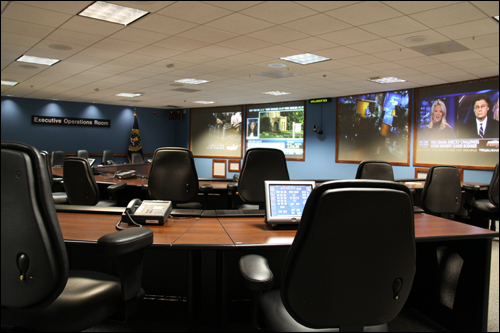SIOC Fact Sheet
SIOC Fact Sheet
History
SIOC was created in 1989 to monitor all major events held in conjunction with the inauguration of President George H.W. Bush. It replaced an ad hoc emergency operations center that was created for specific crisis situations.
In November 1987, simultaneous prison uprisings in Oakdale, Louisiana and Atlanta, Georgia made it clear that FBI Headquarters needed a permanent center to handle several crises at a time. Accordingly, following a feasibility study by the Institute for Defense Analysis, SIOC was designed as a 24/7 command post, capable of carrying out a full range of crisis management functions by one medium and one small crisis action team simultaneously, both in constant contact with field commanders and other law enforcement agencies. It encompassed 4,000 square feet, sat roughly 50 people, and had 85 built-in telephone lines.
In 1995, the FBI undertook a major initiative to upgrade SIOC, reflecting its increased responsibilities and the need to manage interagency coordination efforts which had arisen through presidential directives, federal orders, and laws. Then-FBI Director Louis Freeh made a Congressional request for the Bureau to develop a first-class operations center capable of meeting its growing mission in worldwide law enforcement and national security affairs.

On November 20, 1998, the new SIOC was inaugurated by former President George H.W. Bush during the FBI’s 90th anniversary celebration. The center’s full name is the George Bush Strategic Information and Operations Center, as a reflection of the original SIOC being created for and opened on his inauguration as 41st President of the United States. The center officially opened for business when President Bush pushed the “Full Alert Button” and sent an e-mail to all FBI employees.
SIOC was designed to handle up to eight separate crises and operations of varying sizes at any one time. The SIOC facility can provide breakout rooms for strategic planning sessions and teleconferencing capabilities between members of the many interagency partnerships that represent federal, state, and local law enforcement; military services; and the intelligence community.
In 2008, the Foreign Tracking Program was implemented, which supports the FBI’s commitment to protect the well-being of its employees, their dependents, and its contractors when their overseas positions place them at risk.
Since 2008, SIOC has enhanced its readiness to respond to significant events worldwide by adding the Critical Incident Operations Unit (CIOU). This key unit is responsible for overall coordination and assistance when the Bureau activates a Command Post, Crisis Response Plan, or the FBI’s Disaster Management Plan.
Most recently, through training and collaboration with the Crisis Management Unit (CMU), CIOU has increased participation in special events and exercises and has enhanced its abilities to perform its core mission—to successfully prepare for, respond to, and assist in the resolution of crisis situations, critical incidents, and special events. CIOU is poised to respond 24/7 to a crisis or event that requires the activation of a SIOC command.
Facility
SIOC is comprised of over 40,000 square feet, seats approximately 492 people, and includes 20 rooms to support operations. The center houses 1,110 telephone lines, along with 35 miles of telephone cable, 60 miles of fiber optic cable, and over 600 computer terminals with access to four networks, the Internet, and various FBI databases. There is video and computer connectivity between operational rooms, secure video teleconferencing capabilities at several classification levels (including Top Secret/SCI), and the ability to hold widespread conference communications. The facility also has video wall technology, FLIR feed capability, and other visual displays supporting time-sensitive operational matters. SIOC supports over 37,000 visitors annually.
Currently, SIOC can function as:
- A global 24/7 Watch Command Center;
- A controlled environment for operational missions and fusion cells;
- A crisis management center supporting operational oversight;
- A platform for executive decision-making;
- A training and education center for mission-oriented projects and initiatives;
- An information processing center; and
- A telecommunications center.
09.02.10
| CIRG Links |
|
Counter-IED Operations Investigative & Operations Support Strategic Information & Operations Center (SIOC) Tactical Operations |

